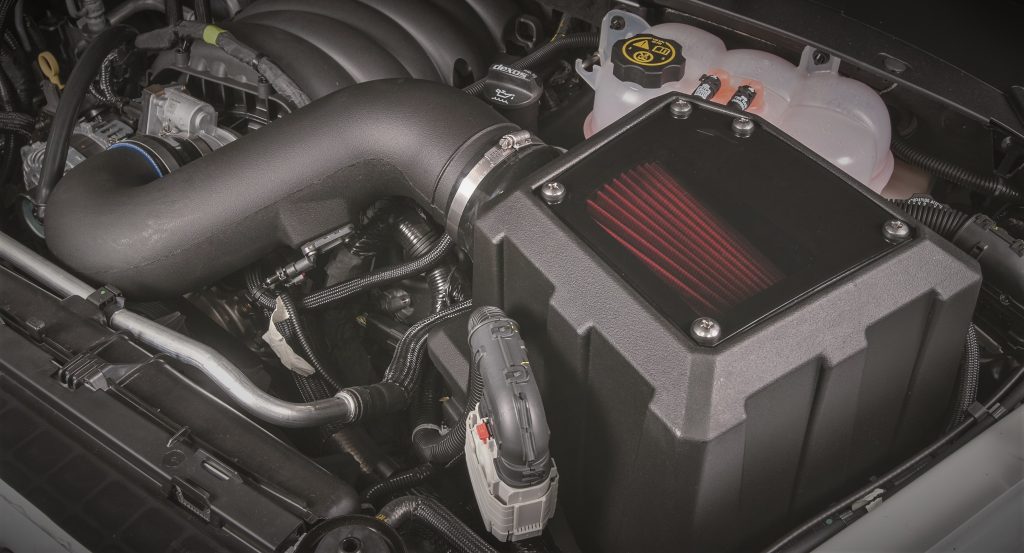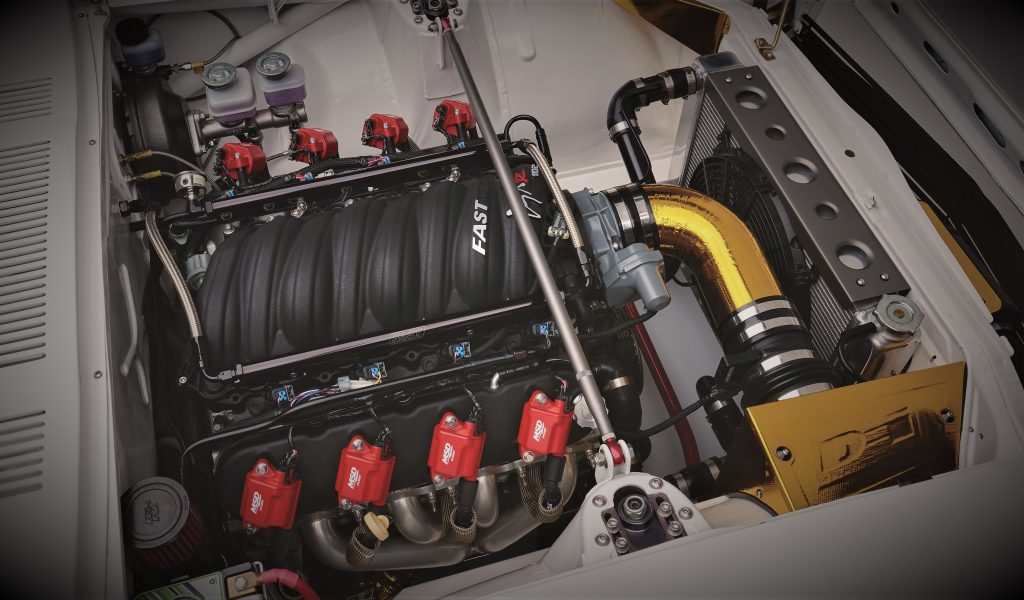A cold air intake (CAI) system is often the first modification a gearhead will make to upgrade their engine. Thanks to easy installation and noticeable performance effect, many enthusiasts consider a CAI to be a “gateway mod” that helps folks new to our hobby begin the path to vehicle performance.
But there are a few things to consider before buying the best air intake kit for your vehicle, and the biggest factor is to check if installing an intake system is legal in the first place.
So we’ll help answer that question—but first, some context.
What is a Cold Air Intake & How Does One Work?

An internal combustion engine requires air (oxygen) to ignite the fuel in the combustion chamber and, as a result, your vehicle has an airbox-style intake from the factory. That stock intake is designed to house an air filter, while preventing water ingress and mitigating unwanted noise—all good things, but for the performance enthusiast, it can restrict the flow of air into the engine.
A cold air intake system replaces much of that factory intake design with large, smoothly-bent tubing and a high flow performance air filter element to increase the flow of air into the engine. More importantly a “cold” air intake usually relocates the air filter element to outside of the engine bay—or at least puts it in a separate space away from ambient engine heat. This helps the engine draw-in cooler, more oxygen-dense air, which promotes better combustion for overall better performance and efficiency.
But since a cold air intake has a direct effect on your combustion and air/fuel mix, it also impacts the function of the emissions-related equipment on your vehicle. That means installing one may put you at risk of running afoul of your state and local regulations. So…
Are Cold Air Intakes Illegal?
The answer largely depends on where you live.
While many states have no restrictions to air intake upgrades, several other states do—and it all starts with California.
When compared to national standards, the California Air Resource Board (CARB) established more rigid guidelines to vehicle engine modifications, including air intake kits, with specific regard to vehicle emissions. That means installing a cold air intake kit that DOES NOT have a Executive Order (EO) exemption will likely be illegal in any state that has adopted those CARB standards.
As alluded to above, if you don’t live in California, several other states carry similar emissions regulations as well. At time of this article, the states/districts following the CARB guidelines include:
- Arizona
- California
- Connecticut
- District of Columbia
- Maine
- Maryland
- Massachusetts
- New Jersey
- New Mexico
- New York
- Oregon
- Pennsylvania
- Rhode Island
- Vermont
- Washington
Understanding CARB EO Exemptions

The good news is, plenty of aftermarket performance intakes have been awarded an Executive Order (EO) exemption, typically expressed as an “EO Number” in a D-XXX-XX format, which makes them legal for sale in those aforementioned CARB states.
We’ll skip the lengthy legalese that accompanies the exemption proclamation, but here’s a snippet of what it says:
IT IS ORDERED AND RESOLVED: That the installation of the Cold Air Intake System, produced and marketed by EXAMPLE, has been found not to reduce the effectiveness of the applicable vehicle pollution control systems and, therefore, is exempt from the prohibitions of Section 27156 of the Vehicle Code for the vehicles listed in Exhibit A.
Sample from a CARB EO Exemption Certificate (You can read the whole document here.)
In less fancy talk, if you’re looking at a Cold Air Intake Kit with a CARB EO exemption described above, you’ll be able to install your kit legally, even in the states listed above that follow the CARB guidelines.
Better still, when you purchase a cold air intake kit that has CARB approval, it’ll likely come with prominent stickers that will clearly state the EO Number on the system itself and, in some cases, you’ll get an extra sticker or two to put in a conspicuous area of your vehicle so you can avoid any legal scrutiny when going in for regular emission testing and/or state inspections.

How to Find a CARB Approved Cold Air Intake Kit
As you’d imagine, if a manufacturer sells an air intake system with a CARB EO exemption, they want you to know about it—because it’s obviously a major selling point.
And that’s good news for you, because that means it’ll be really easy to spot a CARB-approved air intake kit.
For example, the folks at Summit Racing have it plainly listed as an attribute for all of the applicable Cold Air Intake kits available at SummitRacing.com, like-a so:

Don’t see a CARB EO number listed on SummitRacing.com? Then the intake kit is not legal for installation on any vehicles registered in the states from that earlier CARB list.
If you want to make absolutely sure, you can visit the specific manufacturer’s website. Again, if the intake kit is approved by the California Air Resources Board, then the manufacturer will be more than happy to tell you so.
How to Tell If Your Cold Air Intake Kit is Legal

Say you’ve purchased a used vehicle with a CAI kit already installed—how do you know if it’s legal?
For starters, if you can find a specific part number, then it’ll be real easy to consult the manufacturer’s records. Secondly, if you know the vehicle has been previously smogged/passed emissions testing in the your respective state, you may be able to find the CARB EO sticker somewhere in the engine bay, or stuck behind a glovebox, trunk lid, or fuel door.
But if you can’t find a sticker or part number, your best bet might be to purchase a new system altogether and start fresh with good CARB certification—there’s nothing more frustrating than a failed smog test due to incomplete documentation.

Another thing to consider, if your air intake kit is installed on a seriously modified vehicle, then there’s a good chance it was made from a Universal Air Intake Kit.
Though universal intake kits are really, really handy for things like LS engine swaps, retrofits, and upgrades on rare, vintage, and otherwise unique vehicles, since they’re not spec’d to a specific engine or vehicle, a universal kit will not carry CARB EO approval.
More Air Intake Kit Technical Resources
As mentioned at the beginning, an air intake kit is very often the first serious upgrade many enthusiasts make to their vehicles. That means we have oodles (yes, oodles) of tech information, buyers guides, and FAQs on them. Click the links below to learn more.
- Air Intakes 101: One of the Most Popular Power-Builders
- Air Intakes 201: How to Choose an Air Intake
- How to Choose an Air Intake Kit for Trucks
- Prevent Hydrolock with a Cold Air Intake Bypass Valve
- Which Air Intake Tube Material is Better, Metal or Plastic?
- How to Find the Best Replacement Air Filter

If a Cold Air Intake will be passed such as KN or Specter there is No reason a Universal Kit should not pass the Carb …..The only thing that should be considered is the Air Filter itself ……My reasoning is a Piece of 3in Aluminum Pipe is a Piece of 3 in Pipe and that shouldn’t matter if it came off a K&N Cold Air Intake or a Universal Kit that comes off an Online Site ……The Only thing that should be considered is the Make up of the Air Filter itself …..A smog inspection should prove this out …..So the only thing that should be considered is the Air Filter …..I could train a Monkey too Judge if there is something wrong with the Piping leading to the Air Filter